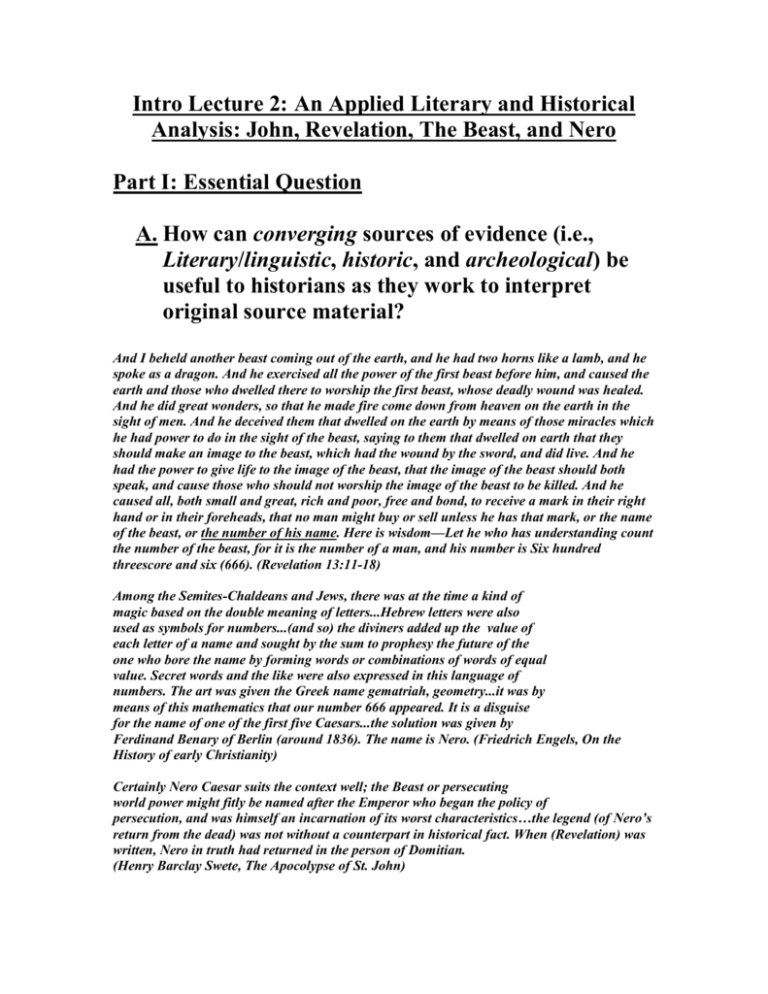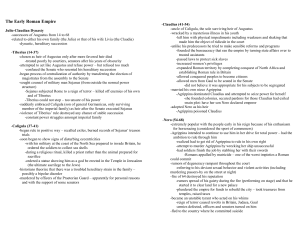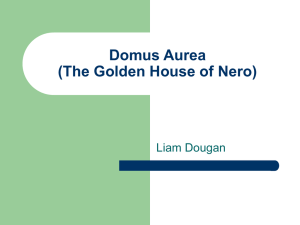L2-Fundamentals of History KEY
advertisement

Intro Lecture 2: An Applied Literary and Historical Analysis: John, Revelation, The Beast, and Nero Part I: Essential Question A. How can converging sources of evidence (i.e., Literary/linguistic, historic, and archeological) be useful to historians as they work to interpret original source material? And I beheld another beast coming out of the earth, and he had two horns like a lamb, and he spoke as a dragon. And he exercised all the power of the first beast before him, and caused the earth and those who dwelled there to worship the first beast, whose deadly wound was healed. And he did great wonders, so that he made fire come down from heaven on the earth in the sight of men. And he deceived them that dwelled on the earth by means of those miracles which he had power to do in the sight of the beast, saying to them that dwelled on earth that they should make an image to the beast, which had the wound by the sword, and did live. And he had the power to give life to the image of the beast, that the image of the beast should both speak, and cause those who should not worship the image of the beast to be killed. And he caused all, both small and great, rich and poor, free and bond, to receive a mark in their right hand or in their foreheads, that no man might buy or sell unless he has that mark, or the name of the beast, or the number of his name. Here is wisdom—Let he who has understanding count the number of the beast, for it is the number of a man, and his number is Six hundred threescore and six (666). (Revelation 13:11-18) Among the Semites-Chaldeans and Jews, there was at the time a kind of magic based on the double meaning of letters...Hebrew letters were also used as symbols for numbers...(and so) the diviners added up the value of each letter of a name and sought by the sum to prophesy the future of the one who bore the name by forming words or combinations of words of equal value. Secret words and the like were also expressed in this language of numbers. The art was given the Greek name gematriah, geometry...it was by means of this mathematics that our number 666 appeared. It is a disguise for the name of one of the first five Caesars...the solution was given by Ferdinand Benary of Berlin (around 1836). The name is Nero. (Friedrich Engels, On the History of early Christianity) Certainly Nero Caesar suits the context well; the Beast or persecuting world power might fitly be named after the Emperor who began the policy of persecution, and was himself an incarnation of its worst characteristics…the legend (of Nero’s return from the dead) was not without a counterpart in historical fact. When (Revelation) was written, Nero in truth had returned in the person of Domitian. (Henry Barclay Swete, The Apocolypse of St. John) The (writer) invites his readers to count the name or number of the beast; i.e., to calculate a name whose letters, numerically valued on the fanciful principles of Gematria, would amount to 666. For John and his readers the beast was primarily the foreign power which opposed the divine kingdom, i.e., in this case, the Roman Empire...but the drift of the present oracle is the further identification of the empire with one emperor, or rather (verse 3) with one emperor in particular...a historic personality...(a number) which answered to an individual...Nero Caesar...The Neronic application would intensify and concentrate its meaning for John's readers who were initiated. (The Expositor's Greek Testament). 1) When discussing the New Testament book of REVELATION during contemporary times, at least two main themes consistently emerge; these are (a) that it is mainly PROPHETIC in nature (i.e., the “beast” referenced above is yet to come) and that (b) it is in part elegantly coded PERSECUTION literature designed to encourage late 1st century followers of Jesus who were laboring under Roman persecution, especially those who dreaded the possible return of their most infamous persecutor, the Emperor NERO. Can HISTORY, especially from the standpoint of LITERARY EVIDENCE obtained through TEXTUAL ANALYSIS along with a CHRONOLOGICAL LISTING of the Roman Emperors, help us to understand what kinds of QUESTIONS are important to ask here? 2) Let’s start with some basic history. As a result of the ROMAN suppression of a Jewish rebellion and the siege of JERUSALEM and the destruction of the TEMPLE around 70 CE, the Hebrews once again experienced extensive dispersion from their homeland. During the 6th century BCE Jerusalem and the temple had also been destroyed and the Jews in Jerusalem (i.e., the Kingdom of JUDAH) were deported to BABYLON by King NEBUCHADNEZZAR; this is known as the BABYLONIAN CAPTIVITY or the Babylonian Diaspora. The permanent διάσόρά of the northern Kingdom of Israel had been carried out earlier by ASSYRIA. 3) Many early followers of Jesus in Jerusalem were likewise displaced at this time; John the Apostle fled to ASIA MINOR (probably to Ephesus) and played a very significant role in establishing and maintaining the early churches there. 4) He exercised his APOSTOLIC authority through visiting these churches and writing letters (EPISTLES) to them. He was known as or elder (our word for elder, PRESBYTER, derives from this Greek word, hence the word PRESBYTERIAN, i.e., the religion of the elders); by the second generation of Christians, was already being used to refer to the first generation of Christians, or the men of the early days. As quite possibly the only survivor of that first generation— that is, of those persons who had actually lived during Jesus’ time—John became o or “the elder,” and this probably accounts for why letters of such briefness JOHN’S TWO EPISTLES are considered sufficiently important to include in the NEW TESTAMENT. 5) John was EXILED to the island of PATMOS. Patmos, a volcanic island located in the Aegean about 50 miles south of Ephesus, was a penal colony; a Byzantine chronicler referred to it as deserted and uncultivated, covered with an made impassable by thorns and shrubs, and by reason of its aridity completely barren. 6) According to Greek tradition, the reason for his exile was as follows: after his arrival in Asia Minor, stories of John performing miracles reached the Roman emperor and great persecutor of Christians DOMITIAN, and so John was called to ROME. Here his power was tested in front of the emperor by making him drink from a cup filled with the same POISON which had just killed a criminal; John remained unharmed. John then raised a girl who had supposedly been killed by an evil spirit. Domitian, impressed by what he had witnessed, decided not to KILL John but instead to BANISH him to PATMOS. 7) John’s offense was that, like many other CHRISTIANS, he threatened the PAX DEORUM (the Peace of the Gods). This was the worship of the traditional Roman Gods which was the glue that held Roman Society together. Rome was extremely TOLERANT of the religions of the people whom they conquered--provided that, once they became part of the ROMAN EMPIRE, such cultures also paid homage and made sacrifice to the traditional ROMAN GODS. Christianity was a NEW religion whose followers REFUSED to honor/sacrifice to these traditional Gods of Rome, and so Christians were viewed as threatening the very fabric of Roman society and thus became easy targets for PERSECUTION. 8) John remained at PATMOS until AFTER the emperor’s death. The precise duration of John’s exile is UNKNOWN, but while there it is said that he converted many of the inhabitants to Christianity. Christian tradition also suggests that it was in a grotto on Patmos that John wrote the FOURTH CANONICAL GOSPEL and, likewise by TRADITION, received the visions that he documented in the book of Revelation, the last book of the New Testament Canon, thus placing the authorship of this text around the end of the first century (i.e., circa 96 CE) during a timeframe corresponding with the persecution of Christians by DOMITIAN. 9) An alternative tradition argues for an earlier date for Revelation’s authorship (c. 68-69 CE) that would correspond roughly to the time of NERO (54-68 CE) who was likewise a great persecutor of Christians; likewise this tradition holds that and that the individual signified by the infamous “666” is NERO. 10) First, let’s look at the LITERARY evidence; here the concept of GEMATRIA becomes central (see the Engels quote at the beginning of this handout!). Many ancient cultures possessed written alphabets but NOT separate characters for NUMBERS, and so LETTERS also represented numeric values (see chart for both Hebrew and Greek numerology!). Thus, it became possible to represent NAMES by using NUMBERS; you can still do this with your own name today! Now, let’s see how, by using Hebrew Gematria, NERO is the numerological equivalent of 666 (please refer to your tables now). 11) This conclusion casts additional light on another section from Revelation that has been used to date this text to the time of NERO instead of DOMITIAN— chapter 17: 10-11—that can assist us with dating this book more precisely: And there are seven kings: five are fallen, and one is, and the other is not yet come; and when he cometh, he must continue a short space. And the beast that was, and is not, even he is the eighth, and is of the seven, and goeth into perdition. 12) There is strong scholarly consensus that the seven kings referred to here are ROMAN EMPERORS. In such a list we DO NOT typically begin with Julius Caesar who ruled at the very end of the ROMAN REPUBLIC, but rather with his adopted son, OCTAVIAN (CAESAR AUGUSTUS), whose rise to power in 31 BCE following his defeat of the combined forces of MARC ANTONY and CLEOPATRA at the Battle of ACTIUM marked the beginning of the Roman IMPERIAL Period (i.e., the period of the emperors during which imperium—the power to command—was invested essentially in a single individual). 13) And so, if at the time of the writing of Revelation five (kings) are fallen, then by reconstructing the chronological listing of the respective periods of rule of the first five Roman Emperors, we should be able to date the writing of this text! (1) Caesar Augustus 31 BCE-14 CE; (2) Tiberius 14-37 CE; (3) Gnaius Caesar (Caligula) 37-41 CE; (4) Claudius 41-54 CE; (5) Nero Caesar (54-68 CE); (6) Galba (68-69 CE)—the one who is or the one who rules still. Hence, five—not SIX or MORE kings have fallen, and so by this reasoning the text was written not during the late 90’s CE but rather during the 68-69 CE timeframe. 14) Hold on a second! What’s thirty years or so within the context of ancient history? Why is it important that this text may have been written thirty years EARLIER than what has traditionally been believed? Here, it is actually very important. Shortly after Nero committed suicide, rumors began circulating that he actually hadn’t died, but had escaped to PERSIA, and would soon be at the head of a vast ARMY and reclaim the Roman crown-hence And the beast that was (The emperor Nero based as we have seen on Gematria), and is not (because he is presumably dead), even he is the eighth (his rule will be restored), and is of the seven (he was among the group of the first seven emperors). Fueling this speculation was the appearance of an IMPOSTER on an island (Kithnos) near Patmos claiming to be Nero. 15) The eighth emperor in the sequence is actually the same DOMITIAN of the time of John. Domitian, as we have seen, was likewise a terrible persecutor of Christians, and so those who support a LATER (i.e., 96 CE) authorship of Revelation argue that, since John was living under Domitian’s rule, he could only refer to him INDIRECTLY as “a beast” in the same sense as Nero. Consider the observations of Swete (1906) The eighth in the series of Emperors is Domitian. But in what sense could he be described as the Beast, or “one of the seven”? The mystery reaches its climax here…a more promising key may be found in the circumstances of the age to which (Revelation) belongs. “One of the seven” had left a reputation which even in the last years of the century made his name a terror. Nero was the very impersonation of the beast, the head which seemed to gather into itself all the worst qualities of the body politic. Nero was gone for a time, but would return as an eighth…a reincarnation of the beast, a revived Nero though not in the sense which popular rumor attached to the phrase. Even pagan writers recognized the resemblance between Nero and Domitian…Nero is supposed by some to stand for Domitian. With St. John living under Domitian and unable to refer to him by name, Domitian takes Nero’s title…as late as the beginning of the third century the name of Nero stuck to Domitian at least in Christian circles (The Apocalypse of John, p. 218). 16) And so, given this input from LITERARY/LINGUISTIC, HISTORIC, and ARCHEOLOGICAL sources, what kinds of questions now make sense to ask? For example, is it possible that the full text of the Book of Revelation wasn’t FINISHED until the time of DOMITIAN, but that John’s revelation regarding the “beast” was received during the time of Nero? What about the interpretation that the Beast itself is the ROMAN EMPIRE, and both NERO and DOMITION are literary manifestations of that larger beast? What else can you think of—and, most critically, can you now approach the development of your questions with a greater degree of insight than you previously possessed? The science of Linguistics allows us to crack the code of the 666 reference as portrayed in the Literary source of the Book of Revelation. Coinage from Nero’s Era provides Archeological evidence for the spelling of his name (i.e., nomenclature).






